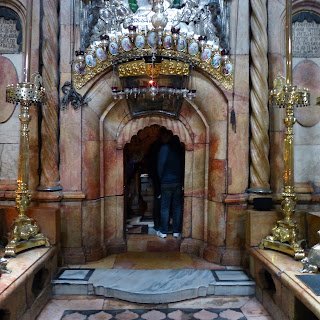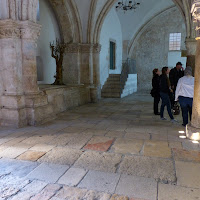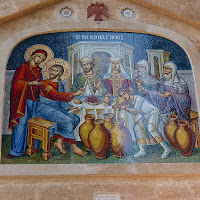6am this morning, while it was still dark outside, and the streets of Jerusalem empty, we picked up our cross and began to follow in the steps of Jesus through the old city.
 |
| Carrying the Cross through Jerusalem |
It was an interesting experience to be able to carry a cross in Jerusalem, and to hear the Gospel stories around Jesus’ Passion, and to pray in these public places.
 |
| Entrance to the Church of the Resurrection |
As we made our way through the Stations of the Cross, we were making our way to the Church of the Holy Sepulcher.
 |
| A picture from the chapel below the place of crucifixion |
It was very meaningful for me to see the rock of Golgotha, the place where Jesus was nailed to the Cross and crucified. In the picture below is the chapel below the place of crucifixion, and you can see the rock of Golgotha behind the glass.
From the place of Crucifixion, we moved to the Empty Tomb. It is a shine decorated in the Greek Orthodox tradition. And the truth is that it didn’t impress me too much - nor should it. He is not there, He is Risen!!
 |
| Entrance to the shrine of the Empty Tomb |
But what did impress me was the artistic connection with the empty tomb and the magnificent ceiling of Resurrection far above - the Great Dome of the Resurrection. As one looks from the empty tomb upwards, you are given that sense of Light and Life.
 |
| Dome of the Resurrection directly above the empty tomb |
As interesting as today’s experience was, it was certainly a reminder to me that God is so much more than these places and things. They are important shrines and reminders of what has happened in our sacred stories, but we are not to hold on to them. Jesus says “I will destroy this temple and raise it up in three days.” Jesus calls us to worship the Father in Spirit and in Truth. He calls us to live the Risen Life of His Divine Love. He calls us to love and serve him in all people, especially those most in need. “What soever you do to the least of my brothers and sisters, that you do unto me.”
Faith in Christ is a living dynamic faith. Faith in Christ is relational in expression and experience. Faith in Christ loves and serves the world.
Faith in Christ is a living dynamic faith. Faith in Christ is relational in expression and experience. Faith in Christ loves and serves the world.












































